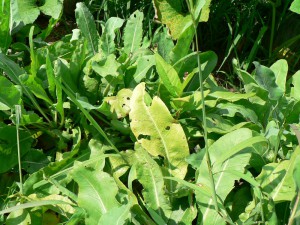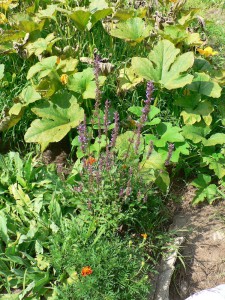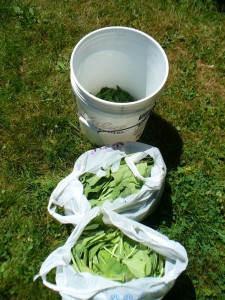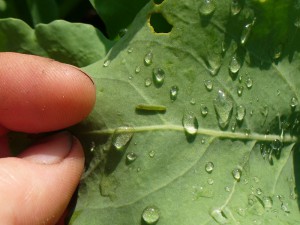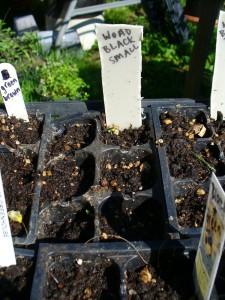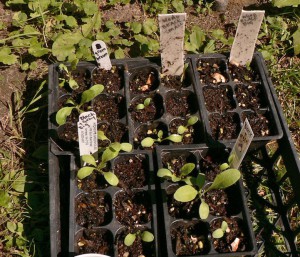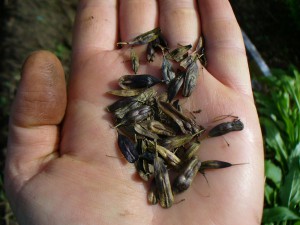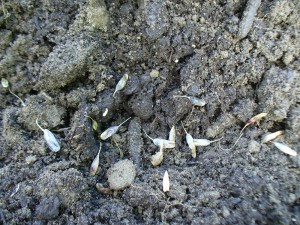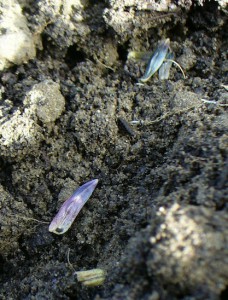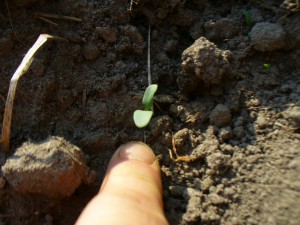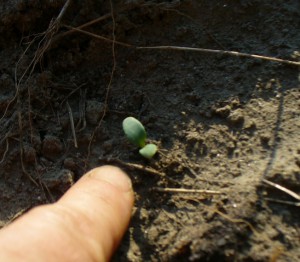Thanks to a couple days off from work, I have sewn up three new books with the Hop Vine motif. Two have a woad-blue pattern weft, and one has madder-pink pattern weft. Continue reading “Hop Vine Books”
Hopvine
My new book cloth is a variation of a miniature overshot motif called Hopvine. To create my threading I worked from two other drafts. One was “Modified Hopvine” from a sampler from the Hill Institute. The other was “Modified Hop Vine” from Marguerite Davison’s classic A Handweaver’s Pattern Book. The threading from Hill had too many ends in each pattern repeat to suit the scale of my book covers (5.5 inches by 8 inches) so I wanted to make the motif smaller. The Davison draft had fewer ends in a repeat but looked weirdly jittery in the drawdown in my weaving software.
So, I tinkered until I found a satisfying balance in the pattern, and am still tinkering with the treadling. The design consists of two different diamonds, one a longer and more pointed and the other a little more squat and rounded. I am not sure if these are supposed to evoke different elements of a hop vine, for example the leaves and the inflorescences. Or maybe the name of the pattern has a different origin. There are some nice images of hops plants here.
For those of you who recall my emboldening tabby travails of a year ago, you might be surprised to hear that I ran into the same problem of keeping a consistent tabby this time, also. Sigh. Continue reading “Hopvine”
First Frost and Woad Thoughts
Where I live in Massachusetts, our first frost is usually the first or second week of October. I feel like it has been creeping later and later in recent years, but tonight (Friday October 12th) our forecasted low is 25 degrees. I always find the first frost to be a bitter-sweet moment in the gardening year. By the time it comes, Matthew and I are usually up to our eyeballs in chilis and tomatillos, there is no room in the fridge, and we are sick of watering and weeding and squishing bugs and trying to defend beets, corn, pumpkins, or what-have-you from unknown assailants…. Continue reading “First Frost and Woad Thoughts”
Another Woad Vat
Yesterday I picked 8 and a half pounds of woad leaves. This is a lot, probably the largest quantity I’ve harvested at one time. Many of the leaves are droopy and yellow at this point in the summer. It has been hot and dry, but there is a lot of color in them, so no worries.
I had written earlier in the summer about woad’s enemies. To fend off the cabbage whites, I planted two hyssop plants, which are supposed to help. I could only find anise hyssop, which may or may not be the right type. It definitely attracts the adult butterflies, as a food source I suspect. But I’m not sure it keeps them from laying eggs on the woad, and it’s the caterpillars that eat the woad leaves, not the butterflies.
I think at this point in the summer that slugs are the main predator on the woad, but I did find quite a few cabbage white eggs. The hyssop is very pretty, though, and it smells great, and the woad is doing OK, so even if the cabbage whites are still laying eggs on it, I guess it’s all fine. Continue reading “Another Woad Vat”
Woad Vat Mishap
The other day I very excitedly set about my first woad vat of the summer. There were lots of supplies and equipment to assemble, dirty 5 gallon buckets to wash, yarns to soak. I got everything ready, and harvested seven and a half pounds of leaves from my glorious woad beds. You can tell from the title of my post that I made a big mistake along the way, but I hope to turn it into a learning opportunity for others, so I relate the tale….
Here are the bags of leaves. They were very clean because we have had practically no rain. Sometimes the leaves are muddy so I rinse them off, but not this time.
Woad Has Enemies
Every year I have problems with cabbage white caterpillars eating holes in my woad. Some years are worse than others. The caterpillars are hard to spot and pick off because they are the exact same color as the leaves, or more precisely, the veins. The butterflies are very pretty, of course, because they are butterflies. I have not been able to get a good photo of a cabbage white butterfly (same problem as my earlier bee post), but click on the link above to see some great ones (12/22/2023 Edited to add, the original link stopped working. The new link to UMass Extension is informative but doesn’t have a lot of images.). And the butterflies don’t do any harm, per se. It’s the caterpillars, or cabbage worms, that are the problem.
Here’s a photo of a particularly small and innocuous-looking one sitting on my woad:
Woad is Glorious
My woad beds are looking fantastic! I am very pleased about this. For the past couple summers, the woad plants at Amethyst Brook have been small and feeble compared to the woad I grew up at the dye- and fiber-plant garden at Bramble Hill Farm. This year the garden at Bramble Hill has been sadly neglected (well, I’ve been distracted by multiple flax plots), so the community garden is my sole source of woad. Consequently, I made an extra effort to add plenty of composted manure before planting this year. And ta-da, success. Here is one bed before I weeded it the other day:
Woad Seed Germination Experiments
In my last post I referred to the germination experiments I did last summer and I went back through old posts so that I could link to the one about woad seeds. However, it turns out that I never wrote about the woad seeds. I spent a long time writing about weld seeds, in the category of “what I did this summer,” then moved on to writing about fall projects.
Here is the belated summary of my woad seed experiments from summer 2011.
I sorted the seeds by color and size. Categories included “black big,” “black small,” “green brown,” “black and gray big,” and “black and green big.” I planted them into little cells with labels.
Here’s a photo of the set up.
And, in short, they all grew. Oddly, the “black big” took longer to grow.
My conclusion from this experiment was that I didn’t need to sort woad seeds and save only the biggest or darkest in color. Also, you need to plant at least twice as many seeds as the number of plants you want, since in each color-and-size category the germination rate was low. I don’t know whether the appearance of the seed has any relationship to the amount of color a plant produces. I doubt it, but it would be hard to prove.
Planting Woad At Last
I have been meaning to plant woad since April, and have had the beds dug for weeks. Not sure what the hold-up has been, but I finally planted one bed last Wednesday morning May 23rd before my shift at Shelburne Arts Co-op.
The soil at our garden is sandy and not rich in organic matter, and woad is a heavy feeder. In the past couple years I have been happy and impressed with my woad plants at Bramble Hill Farm at my little fiber and dye plant garden, and unhappy with my plants at our community garden. In an attempt to get burlier plants at the community garden, I put 6 bags of compost and cow manure into the two beds I dug, and plan to side dress with organic fertilizer during the season.
Here is a shot of the nice dark manure/compost combo:
By the way, I bought the bagged compost and cow manure from Annie’s (12/19/23 Edited to add that Annie’s is sadly no longer in business. I removed the link.). As I was waiting to pay for it, I was in line behind a woman who spent about $100 on lovely gifts that she was getting wrapped up. The process was taking a little while, and I was standing there waiting with nothing in my hands. So the cashier politely asked me if I was being helped. I said it was OK, I was just waiting to pay for manure. Both of the women looked at me for a moment, and the cashier said, “Manure?” I realized the extreme contrast between my purchase and that of the customer in front of me, and replied, “Well, you have it all here.” That is, Annie’s has beautiful things as well as practical ones. And they do.
Which reminds me of another anecdote. The paternal side of my family traditionally plays a card game called Beacon Hill Rummy when we have family get-togethers at our cabin on Queen Lake. It is customary to comment on one’s hand and luck during the game (it’s not poker, in fact it is like the anti-poker) and once a family member described his or her hand as a “sack o’ poo,” meaning it was terrible. Matthew and I commented that we regularly pay good money for sacks of poo for our garden, and in fact it’s probably our biggest expense in gardening. In manure as in cards, one person’s trash is another person’s treasure. This past holiday season, imagine my delight when I saw these (12/19/23 Edited to add that the bags of guano and other fancy poop are no longer for sale. I removed the link) listed in the Pinetree Seeds catalogue. Not a sack of coal, but a sack o’ poo for every boy and girl. Exotic poo.
OK, back to the woad. I plan to plant two large beds. The beds are almost as long as the flax beds (14 feet) but I left a path in between for weeding and watering. So they’re about 13 feet long and 3 feet wide.
Here is a handful of woad seeds.They vary in color from green to purple, but all except the lightest, thinnest yellow ones will grow (I know this from some germination experiments I did last summer).
I have a lifetime supply so I plant wantonly.
Here’s a close-up. I think woad seeds are beautiful. Actually, I think woad might be my favorite dye plant.
As of Monday May 28th the woad is up! Here are some photos of the cute little seedlings.

